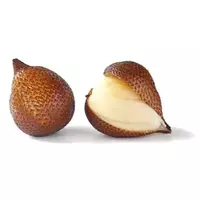Sprats

Snake fruit or herring fruit fully lives up to its unusual name - covered with numerous scales, rough and prickly to the touch, the fruits actually resemble snake skin in appearance. These exotic fruits grow on a small tropical palm tree, which is characterized by a large number of trunks and pinnate leaves. In addition, the axes and petioles of these trunks are covered with spikes.
Countries in Southeast Asia are considered the birthplace of the herring fruit - mainly Thailand, Indonesia and Malaysia. It is said that the most delicious varieties of this plant can be found in Bali and Java near Jakarta, and in other regions the salak practically does not grow.
Huge clusters of fruit, which are red-brown in color, grow at the base of the trunk directly above the ground. The flesh of the mature fruit herring is yellowish-beige in color, it is unusually fragrant and very sweet, but has a rather specific taste. The taste of the fruit can be said to vary by variety.
So, some lovers of exotic fruits describe it as sour-sweet with nutty notes, while to other connoisseurs the taste of the herring resembles a cross between cherries, gooseberries and strawberries. For some, the taste of the fruit pulp is colored in banana-pineapple tones. And interestingly, foodies like these also stand out, describing the sensations of eating the fruits of a herring as the smell and taste of cotton wool filled with corvalol or valerian. Well, how to speak, how many people, so many opinions. . .
Meanwhile, the unseeded fruits of the herring can be both very bitter and tart-sour. By the way, outwardly they are also completely different - from round shapes to almond-shaped (in the form of small bulbs). But they are all painted brown. When the fruit is cut, the herring opens in front of us a pulp consisting of both one and several segments of different intensity of cream color.
As a rule, most people prefer ripe herring fruits for fresh food, but you can cook a lot of delicious dishes from them. Candied fruit or herring jam are especially popular. In addition, some culinary experts have become accustomed to using immature fruits, which are characterized by a sour astringent taste - they are usually pickled as gherkins or pikuli.
However, regardless of the method of cooking, keep in mind: to peel the fruit of the herring, you need to properly adjust otherwise you can easily stab your hands. By the way, experienced chefs often use rubber gloves for these purposes.
herring 50 kCal
Energy value of the herring (Ratio of proteins, fats, carbohydrates - ju):
Proteins: 0 g (~ 0 kCal)
Fats: 0 g (~ 0 kCal)
Carbohydrates: 12g (~ 48kCal)
Energy ratio (b | y): 0% | 0% | 96%
 Español
Español Français
Français Português
Português Русский
Русский 简体中文
简体中文 繁體中文
繁體中文 日本語
日本語 한국어
한국어 العربية
العربية Türkçe
Türkçe Қазақ
Қазақ Deutsch
Deutsch Italiano
Italiano Українська
Українська
